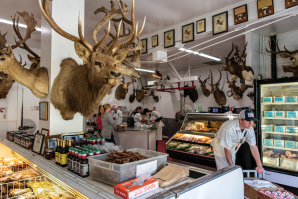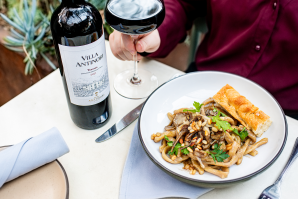On a misty fall Saturday morning, long before most of Sacramento’s residents are out of bed, you’ll find Holly Heyser stamping her feet to keep warm as she waits for the sun to cast some light over the Yolo Bypass Wildlife Area. She’s already laid out dozens of lifelike rubber decoys and carefully hidden herself in a blind. Now, with her duck call — made just up the road in Winters — in her mouth and her Benelli Super Black Eagle shotgun in hand, she’s anxiously awaiting the arrival of shooting light — and the wildfowl that transit the Pacific Flyway as they head south for winter.
Heyser is enjoying the world-class wildfowl hunting that makes Sacramento County home to the most duck hunters of any California county. Tonight, if everything goes well, she’ll be one of the few county residents eating wild game. But first, she must harvest that game, which is no easy task as ducks come from several directions and must be identified by breed and gender before she can be sure it’s legal to take a shot. That shot isn’t easy either; the ducks fly at up to 60 miles per hour, and hunters generally only get a few shots before the whole flock flies past.
Heyser didn’t grow up hunting but came to the activity at 41. Her first hunt, she says, was “electrifying.” “The drive there was a normal drive through the Sacramento Valley,” she remembers, but on the way home, “I couldn’t stop looking out the window. I’m like, there could be birds in there! … Suddenly, all that stuff that just looked empty and meaningless. Suddenly, it was alive.”
That first hunt was a pheasant hunt, but since then, she has found her passion in the marshes and ponds of Sacramento County, and for nearly two decades, she’s spent the cold winter mornings of duck season getting up way before dawn to lay out her decoys and wait for the thrilling first sight of ducks flying out of the early morning twilight.
Sacramento residents like Heyser are overrepresented in hunting license sales, according to data from the California Department of Fish and Wildlife. Sacramento county residents made up 5.61 percent of all license sales in 2024 and just over 1 percent of the state population. Perhaps part of the reason why locals love to hunt is the opportunities they have. Alongside deer, upland game like turkeys and pheasants, and invasive wild pigs, Sacramento offers some of the best wildfowl hunting anywhere in the U.S, and hunters come from across the state and country to enjoy it.
Holly Heyser prepares grilled teriyaki from duck that she hunted.
(Photo by Holly Heyser)

From decoys to duck confit
Just a 15-minute drive from downtown, the 59,000-acre Yolo Bypass area alone saw 64,179 applications for a blind — a hide site from which hunters shoot — in the 2023-2024 season. Only one of every 40 applications was successfully drawn and allocated a blind. Such is the demand for accessible public land hunting from hunters across the state.
For many, hunting is not about traveling, but about reducing food miles and trying to eat sustainably. Heyser says she first decided to become a hunter when she was eating wild ducks harvested by her ex. “We were eating them like corn on the cob … the fats dripping down our chins and the cats circling the table,” she says in a phone interview before taking a break from the call to attend to a duck confit she was preparing. “I think that was the night when I said, ‘OK, I want to do this. I’m ready to get my license and get a gun!’”
According to Peter Tira, an information officer at the California Department of Fish and Wildlife, a lot of people come to hunting out of a desire to eat healthier, tastier and more ethically sourced animal protein. New hunters, Tira says, often “want to know where their food comes from. … They want to know that any animal lived a healthy, free, honest lifestyle; no hormones, no antibiotics, not genetically engineered … a wild animal.” Heyser points out that “you don’t know where these animals have been eating,” but agrees the flavor in wild game is incomparable to store-bought meat, something she says she very rarely purchases.
The only way to access this kind of wild meat is through hunting. While the U.S. has allowed “market hunting” in the past, today it is strictly forbidden, and hunters cannot sell the animals they harvest, although several local butchers and restaurants, including Roseville Meat Company in Roseville and Frank Fat’s in Sacramento, will prepare and cook game for a fee if hunters bring it to them. This is just one of many regulations that hunters in California must learn — through taking a hunter’s safety course — long before they can ever pick up a gun and head into the field.
Swingle Meat Company is still decorated with the taxidermied
heads of game animals, though it no longer processes wild game.
(Photo by Debbie Cunningham)

“The average person going about their life has no idea this subculture exists,” Tira says, but he’s working to change that. “California is actively recruiting hunters,” he adds. “That’s a surprise to a lot of people, but we are part of a nationwide movement called recruit, retain, reactivate.”
The Fish and Game program, also known as R3, is managed by Taylor Williams. It aims to bolster declining hunting numbers, recruit younger adults to become first-time hunters and remove barriers to participation.
While California is both ecologically and socio-politically diverse, the hunting community is less diverse than the state. Nationwide, 99 percent of duck hunters are white. California is ahead of the rest of the nation, with 19 percent of hunters being nonwhite, but has some way to go to make hunting demographics reflect those of the state as a whole. Gender representation is also not reflective of the state, with Heyser being one of only 10 percent of California’s hunters who are women.
Things are changing though, according to Heyser. When she first began hunting, she says, she’d frequent forums and Facebook pages to learn more. On those pages, she says, “a guy would talk about taking his son hunting, and some other guy would comment, ’I only have daughters, so I don’t get to take anyone out.’ That’s completely gone. Now, when I look at the forums and the Facebook groups … there are so many proud dads taking out their daughters, and increasingly proud moms taking out their sons and daughters.”
Heyser is an example of the success of the R3 program, and since becoming a hunter, she’s encouraged others through mentorship, seminars and webinars, as well as volunteering for women’s hunting programs. With Outdoor Afro CEO Rue Mapp, she co-founded the Black Heritage Hunt, which hosts an annual beginners’ duck hunt near Sacramento.
Fish and Wildlife is also invested in reducing barriers to hunter participation. Tira traveled to San Francisco recently to instruct physical education teachers in the city about archery, which they can then share with pupils. Even if those pupils never fire a bow at anything except a straw target, they now have access to an activity that is meditative and relaxing.
Heyser says that one of the concerns she had as a new hunter was that she’d become “indifferent to the suffering of animals.” However, she’s found the opposite. “It actually made me way more empathetic to animals. … I used to be pretty indifferent about a lot of animals, and now I’m not. I’m a total animal freak! I rescue worms when they’re up on the sidewalk after a big rain or something. I mean, I’m nuts about it!”
People might not associate hunting and conservation, but Tira explains that the link goes deeper than an appreciation for nature. The Federal Aid in Wildlife Restoration Act funds conservation efforts through a tax on firearms, ammunition and archery equipment. These funds help with wildlife restoration projects and are supplemented by the more than $12 million the CDFW received from license sales alone last year.
A federal duck stamp from 1981. (Shutterstock photo)

Other programs, such as the Federal Duck Stamp, which hunters like Heyser must purchase to hunt ducks, raise money for the conservation of specific species. In the case of the duck stamp, more than $38 million was raised in 2023. The artist for the stamps is selected through an annual national competition, and each year features a different duck species. For the duck-obsessed like Heyser, the collectible stamps are a chance to celebrate the beauty of the nation’s wildfowl and support its conservation.
Mentors in the marsh
It’s not just on stamps where Sacramento’s wildfowl hunters display their artistry. The region is home to several manufacturers of meticulously crafted duck calls, which Heyser and others use to try to entice high-flying wildfowl to come down to their decoy arrays. A multi-million-dollar hunting clothing brand, Kuiu, is based in Dixon, but declined to be interviewed for this story.
With hunting opportunities just 15 minutes from downtown Sacramento and the activity playing a large part in the local economy, what keeps 95 percent of people from participating? Williams says a big issue is social support. Heyser says she tries to bridge this gap through public advocacy and mentorship. “I love mentoring new hunters,” she says. “I don’t care, women, men, whatever color you are; I’m really into helping everyone hunt if they want to hunt.” She is keen to point out that although most hunters are men, it can still be difficult for novice men to find a mentor. “If you’re a guy and you walk into the marsh, everyone just assumes you know what you’re doing.”
A male northern shoveler at Yolo Bypass Wildlife Area near
Sacramento. (Shutterstock photo)

Anecdotally, this writer has found that for many would-be hunters interested in the sustainable and healthy food harvest, acquiring a firearm is an insurmountable barrier. Heyser points out that customer service for women can also be poor at some firearms retailers but adds that her experiences in Sacramento have been great: “I was always treated with respect,” she says.
Thankfully, California offers bowhunting opportunities for many species, including deer, upland birds and small mammals. Indeed, some popular species to hunt, for which hunters must enter a lottery to draw a tag, offer longer seasons and special tags for bowhunters. But, Tira says, using a bow is “a harder way of hunting. … You have to be a much better hunter” to be successful.
New hunters tend to underestimate the difficulty of bringing home wild game from public land, Tira says, and many become disheartened. Hunting, as Heyser mentioned, is one of the few things one can’t learn on YouTube in 2025. The state offers apprentice pheasant hunts, like the one Heyser attended, where new hunters can hunt stocked pheasant in a safe environment alongside a mentor and sometimes borrow a shotgun, ensuring a safe and likely successful first hunting experience.
Through these hunts, they hope to create more hunting and conservation advocates like Heyser, who spent well over an hour sharing her passion for ducks during a recent interview, only pausing to stir a duck confit and to pet her 19-week-old puppy, Fritzy, who she hopes will be joining her next fall for many more years of early mornings and cold feet in the duck blinds of Yolo Bypass.
–
Stay up to date on business in the Capital Region: Subscribe to the Comstock’s newsletter today.
Recommended For You

How Meat Markets Meet Needs
Traditional butchers find that skills from the past equal hope for the future
These Capital Region butcher shops are family-owned
businesses that offer meat from high-caliber livestock and
the magic of housemade marinades.

In Northern California, the Natural Landscape Lures Outdoor Lovers With a Wide Variety of Recreational Activities
Great outdoor adventures abound in the Capital Region and beyond
Beautiful natural resources like this make Northern California a popular destination for recreation lovers. In fact, in California in 2023, some $81.5 billion was generated from outdoor recreation, according to the U.S. Bureau of Economic Analysis. Let’s head outdoors.

Chefs, Growers and Citizen Scientists Are Embracing Mushroom Foraging and Its Culinary Potential
The farm-to-fork pipeline is well established in Sacramento — but what about forage-to-fork? We talked to some of the foragers, scientists, chefs and enthusiasts who want to see more foraging in the Capital Region.

What’s on the Horizon for California’s Public Lands?
With less funding in the current budget, the management of public lands is likely to change substantially, and this may have massive and unforeseen consequences for Californians.




